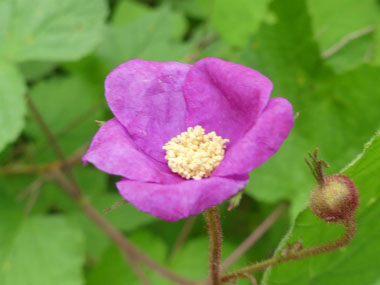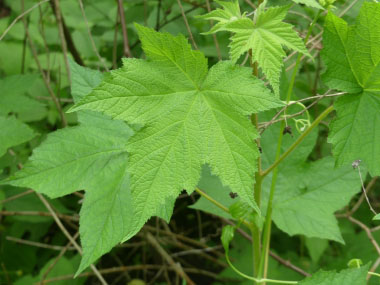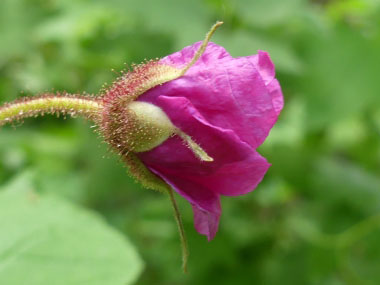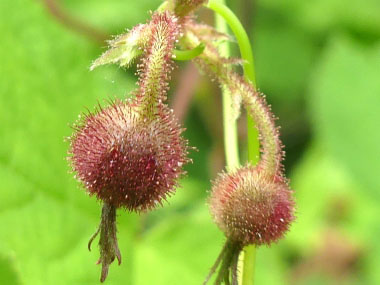






To support our efforts please browse our store (books with medicinal info, etc.).
Purple flowering raspberry is a fast growing multi-stemmed deciduous shrub that forms an upright spreading open mound and it tends to be leggy. It is a suckering plant that forms large colonies. It is in the rose (Rosaceae) family. The genus name is the Latin name for brambles and the specific epithet means fragrant.
Trunk/Bark
Unlike many other rubus shrubs, this shrub has hairy stems but virtually no thorns. The stems are woody, and very pale brown.
Branches/Twigs
N/A.
Height
1.5 to 2 metres (5 to 7’) and it can get to widths up to 1.5 metres (5').
Leaves/Needles
Large soft green maple-like leaves turn yellow in the fall. Fragrant, licorice scented foliage. Medium green with a slightly hairy surface. The leaves are alternate, palmately lobed with five (rarely three or seven) lobes, up to 25 cm (10”) long and broad.
Flowers
Fragrant pinkish-purple flowers from June to September. Flowers have 5-petaled clusters. Sepals are covered with glandular hairs. The flowers are 5cm (2”) across. The centre of the flower is a mass of stamens with yellow anthers. The stamens surround a central yellowish-green receptacle of carpels which is hidden by the anthers until the petals fully expand and spread outward.
Fruit
Red berries are edible and can be used in jellies, pies, etc. However, not very palatable as they are tart, dry and very seedy. Enjoyed by birds. Fruit is a dry, aggregate, purplish-red drupe that resembles a fuzzy, flat raspberry. Fruits ripens in mid-to-late summer.
Habitat
Purple Flowering Raspberry grows in well drained soils with medium moisture content. It does best in sun but tolerates shade well. It suckers and forms thickets and can be an aggressive spreader. They prefer woodland areas but can be grown in gardens.
Edible Parts
Fruit can be consumed raw or cooked. Somewhat tart and dry, it is usually cooked and used in pies, jellies, preserves etc. The fruit can be dried for later use.
Other Name
Flowering Raspberry.
Recipes
Winter Survival Food Handbook

PDF Plant Magazines
Types of Wild Food
Geographic Zones Seasons
Disclaimer
EdibleWildFood.com is informational in nature. While we strive to be 100% accurate, it is solely up to the reader to ensure proper plant identification. Some wild plants are poisonous or can have serious adverse health effects.
We are not health professionals, medical doctors, nor are we nutritionists. It is up to the reader to verify nutritional information and health benefits with qualified professionals for all edible plants listed in this web site. Please click here for more information.
Why Edible Wild Food?
- Food costs are rising
- Free, wild food is readily abundant
- Wild food adds nutrition to your diet
- Wild food can help treat various medical conditions





